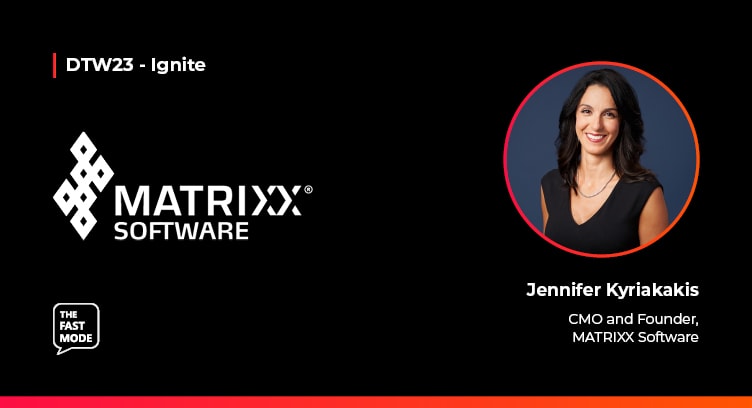With DTW23 - Ignite set to begin tomorrow at the Bella Center, Copenhagen, Ariana Lynn, Principal Analyst at The Fast Mode spoke to Jennifer Kyriakakis, CMO and founder of MATRIXX Software on the company's participation at the upcoming event. Jennifer reveals MATRIXX's planned product launches, collaborations, showcases as well as her thoughts on generative AI.
Ariana: What products / solutions will MATRIXX be showcasing at DTW23? Can we expect to see any new launches?
Jennifer: Yes, DTW is the grand coming-out for our digital monetization solution designed to transform traditional BSS architecture and enable service providers to retire billing legacy systems and processes.
Our digital monetization solution leverages modern digital business architecture to unify all rating and charging, regardless of the customer, service, or payment type, create enhanced customer experiences, and provide a platform for CSP innovation to explore new use cases and new business models. All monetization functions are performed in real time to give customers more transparency across their services and spending—and resulting in faster revenue collection for CSPs. With this, CSPs can eliminate traditional batch, cyclical billing processes that slow time-to-cash, cause customer confusion and out-of-synch balances, and require a lot of reconciliation effort.
Our solution also offers needed architectural flexibility to incorporate new business models as cloud, edge, and 5G SA services evolve.
Aligned with TM Forum’s Open Digital Architecture, our digital monetization solution marks a significant stride forward in the evolution of the telco industry, providing a path for service providers to transform from legacy BSS to a digital business architecture based on convergence, composability, and cloud native principles. With MATRIXX, monetization functions are unified and reusable, delivering real-time revenue and creating an agile, growth-centric business.
Ariana: Are there any plans to collaborate with other exhibitors or sponsors? Will MATRIXX be running any joint demos or showcases?
Jennifer: Yes, we are working with partners on two TM Forum Catalyst projects that we’re excited to highlight on stage during the conference. Both of these are in Phase III. We are also part of a Proof of Concept that we expect will lead to a formal catalyst in the next cycle.
The first catalyst project is with Deutsche Telekom, Telecom Egypt, Airbus, IBM, SAP, MYCOM OSI, and Flytxt. We are demonstrating integrated, automated, and intelligent multi-operator service assurance capable of delivering consistent SD-WAN access and transport services that are powering enterprise Industry 4.0 use cases.
This solution focuses on real-time service levels and monetization, network orchestration, and automating service assurance for proactive identification of network issues. It provides a state-of-the-art customer portal displaying real-time service levels and balances, real-time monetization including SLA credits, and Generative AI-powered recovery plans or upgrade recommendations.
Our second catalyst project is with Telefónica Germany, NTT, NTT DATA Europe & Latam, Hewlett Packard Enterprise, and Salesforce. This project unlocks B2B2X value in 5G smart space and helps operators increase their revenues through the commercialization of new digital products and services by supporting operator offerings with network (RAN) and edge computing nodes that can be reused across operators. This reduces costs and energy alike.
The third project is a Proof of Concept with TM Forum and Google to demonstrate deploying components on Googe’s Open Digital Architecture (ODA) Canvas. In this initiative, we set out to validate that we could deploy MATRIXX microservices as components and take full advantage of the canvas environment services, like security, identity, and service mesh, to easily deploy and be discoverable by other components. Our architects were delighted with the results from their very first attempt at deploying MATRIXX components on the Google ODA canvas, proclaiming “This is truly a plug-and-play experience!” This PoC will be featured in TM Forum’s Tech Tour on Wednesday during DTW, where they will guide guests through multiple stations in the Expo to view various highlights of ODA deployments.
Ariana: What are your thoughts on artificial intelligence (AI), specifically generative AI? Where is it heading?
Jennifer: MATRIXX telco customers have always recognized the value of the vast amounts of data they generate and manage, from their networks and customer utilization, and they have, in a relatively short period of time, already jumped into the Gen AI fray. Numerous trials are being architected or are already underway, and MATRIXX is working with customers and our technology partners to explore the possibilities of deploying Gen AI in the revenue optimization domain.
The promise of Gen AI-driven revenue optimization is to transform critical, data-intensive telco operations that have long been retrospective – processing and analyzing massive amounts of historical network performance, service quality, charging, and revenue stream data that has already transpired – into proactive operations. The combination of (1) a vast historical telco revenue dataset, a trained, (2) expert AI to generate intelligent forward-looking models, and (3) a real-time monetization engine are critical pillars that our customers, our partners, and the MATRIXX platform will combine to recreate the telco business model.
Example use cases that we are exploring include:
- Gen-AIOps to automate proactive network configuration to provide guaranteed or improved service levels – down to the micro-segment of a single connected IoT device, that a customer will generate incremental revenue;
- identification and prediction of revenue stream anomalies to rapidly address fraud ad revenue leakage; and
- models that recommend how to financially treat customers who are showing signs of trouble or dissatisfaction, but offering credits or recommending a change in their offer to one that is better suited to their needs at the moment.
Telcos today are at a crossroads where they have no choice but to reinvent themselves. Revenue growth has stalled; the significant investments made in 5G are a long way from generating returns; and investors and stakeholders expect better results. We at MATRIXX believe that the fortunate confluence of digital business architectures, the step-change in services capabilities that 5G SA brings, and Gen AI mean that telcos have the tools to, finally, transform themselves for the future.




















